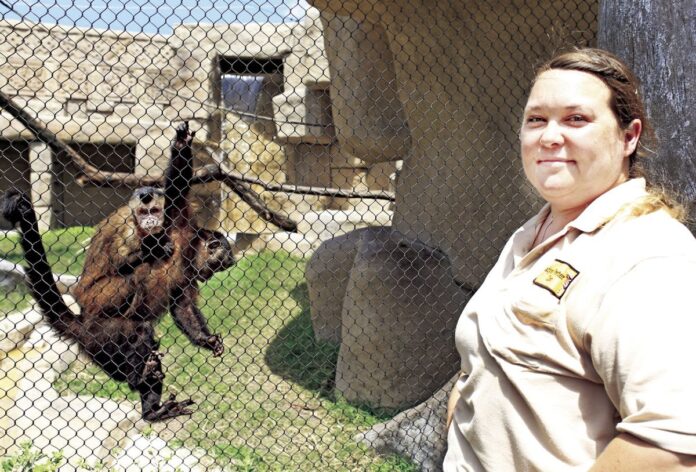BROWNSVILLE — Nobody knows more about Gladys Porter Zoo’s tufted capuchin monkeys than Emma Mitchell.
Six of the primates, native to South America, inhabit the zoo’s El Mundo Huasteco Totonaco exhibit, which opened in 2017. Their names, in rough pecking order, are Houston, Minnie, Jack, Jill, Sugar and Katie. Mitchell said it’s young Jack who likes to stir things up.
“He’s very mischievous,” she said. “He’s one of the ones in the group that will actually plot things, and he will get everyone started.”
Jack’s playmate is Jill, who oftentimes backs him up when he “gets in a mood,” Mitchell said. Sugar, on the other hand, is a peace-loving soul who cries at the first whiff of trouble, she said.
“There’s so much going on here socially, you just wouldn’t believe it,” Mitchell said.
Also known as brown or black-capped capuchins, the primates are extremely intelligent and the sole New World monkey to use tools, she said. Capuchins are frequently seen on TV shows and movies, leading many people to want them as pets, which is a very bad idea. In fact, it’s hard to imagine a worse pet, said Mitchell, who is fundamentally opposed to trade in exotic animals, legal or otherwise.
If you think corralling an errant human toddler is tough, try chasing a 2-year-old monkey intent on mischief, she said.
“They can climb,” Mitchell said. “They have a prehensile tail. They have huge canine teeth. And what do you do with them once they get old enough to where they’re causing so much trouble and they’re destroying your house? These guys are really smart.”
Capuchins can live to be 45 years old, another issue many people don’t consider, she said. It’s much better to admire the monkeys at the zoo, Mitchell said, though she’d like people to stop feeding them. Some visitors might think they’re doing zoo residents a favor by slipping them treats from the concession stand, but they’re really doing the opposite, she said.
“These guys have really sensitive stomachs,” Mitchell said. “We have a whole nutrition panel and a veterinarian that we consult on what kind of diet they have. I assure you it doesn’t involve Cheetos.”
Taking care of the capuchins every day, she’s developed a strong affection for them, Mitchell said.
“I love them very much, and their care is very important to me,” she said. “I do bond with them, but I bond with them each differently based on their personalities.”
Mitchell, also in charge of the capybaras, nilgai and all things Australian at the zoo, concedes it’s hard work, observing, “there’s a reason poo rhymes with zoo,” but insists she’s passionate about the work and considers it her dream job.
Ten years ago, when her husband’s company transferred him from up north to the Rio Grande Valley, Mitchell, an animal lover who always had wanted to work for a zoo, started volunteering for Gladys Porter’s “Small World” education program. Eventually, she was brought on as a staff member.
“The silly gooses, they hired me,” Mitchell said. “I probably would have kept on working for free.”




